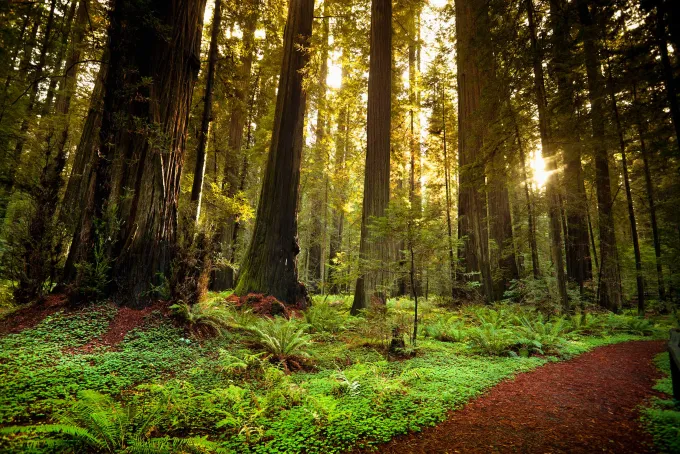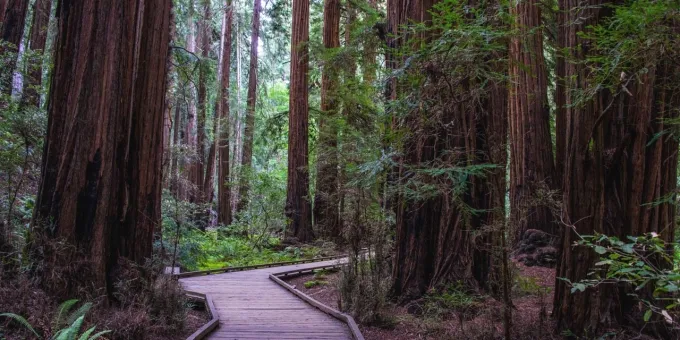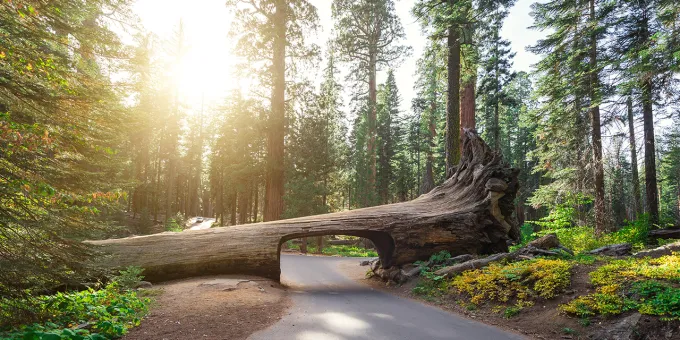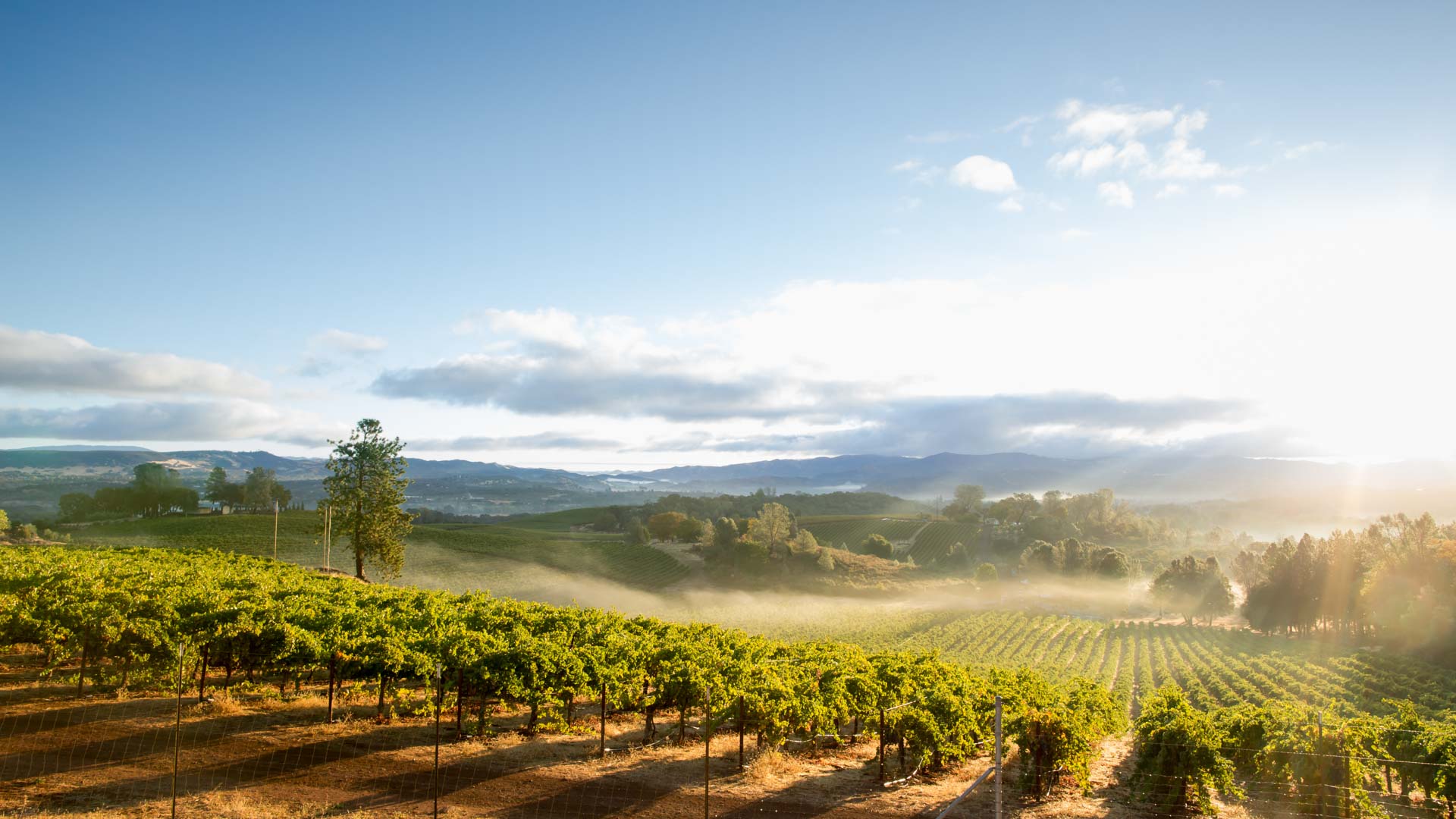Get ready to look up—way, way up. California has the biggest, tallest trees on the planet. Discover them at outstanding parks and preserves dotting the state. Coast redwoods, some topping out at well over 350 feet—and still growing—live in a narrow coastal band from roughly Big Sur to the Oregon border. (Check out our Insider’s Guide to California’s Redwood Coast to explore this wild region.) Giant sequoias, with trunks measuring more than 30 feet in diameter, grow on the west side of the Sierra Nevada, with some trees starting out as seedlings some 3,500 years ago. Here’s where to find them, listed north to south.
Redwood National and State Parks, Del Norte and Humboldt Counties
At the stunning preserves known as Redwood National and State Parks, the soaring redwoods line up like living skyscrapers. Of the five visitors centers, the southernmost is the excellent Thomas H. Kuchel Visitor Center, one mile south of Orick, with numerous exhibits about redwood ecology, a great bookstore, and access to a sandy beach. Nearby is the crowd-pleasing one-mile walk through Lady Bird Johnson Grove, which goes underneath towering redwoods This cluster of national and state parks also includes Jedidiah Smith Redwoods State Park and Prairie Creek Redwoods State Park. (More: Redwood State and National Parks)
Avenue of The Giants, Humboldt County
As you wind through the forest, along a narrow strip of U.S. 101, the Avenue of Giants offers the chance see coast redwoods so close and so tall that they create a dramatic wall of enormous russet trunks. Take some fun detours along this 32-mile route, such as the tiny cottage-lined town of Scotia, the café-and-gift shop One-Log House, and the Shrine Drive-Thru Tree. (More: Avenue of the Giants)
Humboldt Redwoods State Park, Humboldt County
Avenue of the Giants actually runs right through the 53,000-acre Humboldt Redwoods State Park, the world’s largest stand of old-growth redwoods and home to an assortment of loop trails. Take the 7.5-mile Bull Creek Loop, which gives you a glimpse of the remarkable Rockefeller Forest, home to the world’s 2nd, 4th, 6th, and 8th tallest trees. Also visit Founders Grove, honoring the people behind the formation of Save the Redwoods League in 1918, an organization that played a critical role in the permanent protection of these remarkable trees. (More: Humboldt Redwoods State Park)
Calaveras Big Trees State Park, Calaveras County
Established in 1931, the Calaveras Big Trees State Park is home to a stunning stand of giant sequoias in the Gold Country. There are two groves at this 6,498-acre preserve: the North Grove (the most visited), and the quieter South Grove. Reserve a site at one of the two large campgrounds, book one of the four basic cabins, or pitch your tent at one of five more remote walk-in sites. Summer is the busiest time of year, but come in spring to see the white dogwood blossoms, or in autumn for colorful foliage that provides a striking contrast against the russet sequoia trunks. (More: Calaveras Big Trees State Park)
Muir Woods National Monument, Marin County
Just north of the Golden Gate Bridge, Muir Woods National Monument was established in 1908 by President Theodore Roosevelt to protect the last stand of uncut old-growth coast redwoods in the Bay Area. Walk along raised boardwalks, built to protect the redwoods’ sensitive root structure, to see the arrow-straight trees, some over a century old. Keep in mind that the road to the park is twisty and narrow, and parking lots can fill up early in summer and on weekends. Make it easy on yourself by taking the public Muir Woods shuttle (March through October) from nearby Sausalito. (More: Muir Woods National Monument)
Big Basin Redwoods State Park, Santa Cruz County
About an hour from Silicon Valley, Big Basin Redwoods State Park is California’s oldest state park, an emerald gem in the Santa Cruz Mountains. While the Santa Cruz County park sustained damage during the 2021 wildfires, it has 80 miles of trails, winding through redwood groves and other habitats. Trekkers love the 10.5-mile Skyline to the Sea Trail, as well as gentle rambles such as the 4-mile Sequoia loop trail (complete with a small waterfall), and the .5-mile Redwood loop trail. You might even get to kiss a banana slug—a belt-notch experience for many a Northern Californian. (More: Big Basin Redwoods State Park)
Mariposa Grove, Yosemite National Park
Dating back to 1864, Mariposa Grove is the oldest of Yosemite’s sequoia groves. In 2018, the area underwent a restoration designed to revive ecological processes, protect wildlife, and minimize the impact of car traffic on the 500 mature giant sequoias. Park at the Mariposa Grove Welcome Plaza and hike the two miles in, or near Yosemite’s south entrance to take a shuttle to the grove. You can also see giant sequoias in the national park at Tuolumne Grove and Merced Grove. (More: Wawona & Mariposa Grove)
Sequoia & Kings Canyon National Parks
The side-by-side Sequoia & Kings Canyon National Parks boast the highest point in the lower 48 (Mount Whitney) and one of North America’s deepest canyons, but their showstoppers are still the enormous trees. In Sequoia National Park, head to the aptly named Giant Forest to see the most impressive collection and access the cathedral-like majesty of towering trees like the General Sherman, the largest living thing on earth by volume. Come between December to April to see the sequoias crowned in fresh snow; rent cross-country skis, snowshoes, and other snow-play gear at Grant Grove, Wuksachi Lodge, and Montecito Sequoia Resort. (More: Sequoia & Kings Canyon National Parks)
Trail of 100 Giants
The Trail of 100 Giants is a popular hiking path located in the Sequoia National Forest. Spanning approximately 1.3 miles, this easy, paved trail weaves through a grove of giant sequoias, many of which are estimated to be up to 1,500 years old. Some of the trees reach heights of over 200 feet and diameters approaching 20 feet. Conveniently, the trail is accessible for all ages and skill levels, including those with mobility challenges. Interpretive signs along the path provide information about the ancient trees and their ecosystem.
Pfeiffer Big Sur State Park, Big Sur
John Pfeiffer settled on some 160 acres of what is now Pfeiffer Big Sur State Park, and you can still see his 1884 cabin here. In the 1930s, he spurned offers from developers and sold his land to the state of California instead. A small but appealing network of well-marked trails wends through the 1,000-acre preserve; along the Big Sur River you can see redwoods, conifers, cottonwoods, and willows, along with spectacular views of the Big Sur Valley and Pacific Ocean. About 10 miles south in Julia Pfeiffer Burns State Park, do the 1/2-mile round-trip Waterfall Overlook Trail—possibly the biggest-bang-for-not-much-work hike on the planet. The almost-flat stroll in the park—dotted with redwoods, tan oaks, madrone and chapparal—ends at an oceanfront overlook with flawless views of 80-foot McWay Falls, a favorite spot of Big Sur pioneer woman Julia Pfeiffer Burns. The beach below is closed to the public, as are a few of the trails, due to erosion—so always check the trails section of the park’s website before traveling. (More: Pfeiffer Big Sur State Park)
Limekiln State Park, Big Sur
Sitting off Highway 1, Limekiln State Park was the site of a booming limekiln operation during the 19th century. Back then, limestone harvested from a nearby slope was fed into kilns (fueled by felled redwoods) to create pure lime, a key ingredient for construction cement used in San Francisco and Monterey. Once the reserves of limestone and redwoods were used up, the kilns were abandoned. The forest recovered, though, and the second-growth redwood stands in this park today make for a pleasant and shady escape. The four old iron-and-stone kilns still stand, too, like monuments to a bygone civilization. (More: Limekiln State Park)



